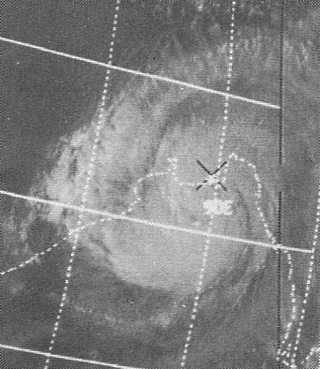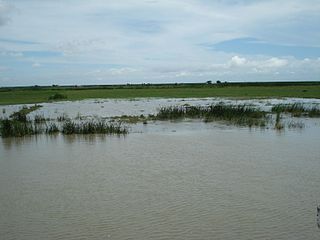
The 1970 Bhola cyclone was a devastating tropical cyclone that struck East Pakistan and India's West Bengal on November 11, 1970. It remains the deadliest tropical cyclone ever recorded and one of the world's deadliest natural disasters. At least 300,000 people lost their lives in the storm, possibly as many as 500,000, primarily as a result of the storm surge that flooded much of the low-lying islands of the Ganges Delta. Bhola was the sixth and strongest cyclonic storm of the 1970 North Indian Ocean cyclone season.
MVSalahuddin-2 was a ferry that sank in the Meghna River south of Dhaka, Bangladesh in the night of 3 May 2002, killing more than 450 people.

Bhola Island is the largest island of Bangladesh with an area of 1,441 km2. It is most of the land area of Bhola District in Barisal Division.

Manpura Island is an island in the northern Bay of Bengal, Bangladesh, at the mouth of the Meghna river. It consists of Manpura upazila, Bhola District. The island has an area of 373 km2. Other major offshore islands of this region are Bhola Island and Hatia Island. All of these islands are densely populated.

The sinking of MV Teratai Prima occurred on January 11, 2009, around 04:00 local time when a ferry carrying more than 300 people capsized in the Makassar Strait off West Sulawesi, Survivors stated that the ferry had been slammed by 4-metre (13 ft) waves twice. The first one hit so hard that the ship became unbalanced, before another wave hit from a different direction and sank the vessel.
MVCoco-4 was a ferry that sunk near Bhola Island, Bangladesh on 27 November 2009, killing 75 people, out of more than a thousand on board, with several dozen more reported missing.

The MV Shariatpur 1 was a double deck ferry that capsized in March 2012 after colliding with a cargo ship on Bangladesh's Meghna River, killing 147 people.
On 30 April 2012, a ferry carrying about 350 passengers capsized in the Brahmaputra River in the Dhubri district of Assam in Northeast India. The disaster killed at least 103 people.
MV St. Thomas Aquinas was a Philippine-registered passenger ferry operated by 2GO Travel. On 16 August 2013, the vessel collided with a cargo ship named MV Sulpicio Express Siete of Philippine Span Asia Carrier Corporation causing it to sink. As of 3 September 2013, there were 108 dead and 29 missing with 733 rescued as a result of the accident.
On 15 May 2014, the double-decker ferry MV Miraj-4 capsized in the Meghna River, 50 kilometres (31 mi) southeast of Dhaka, Bangladesh. Between 150 and 200 people were on board at the time, of whom about 75 survived. As of 17 May, the official death toll stood at 54 with an unknown number of people missing.
2014 (MMXIV) was a common year starting on Wednesday of the Gregorian calendar, the 2014th year of the Common Era (CE) and Anno Domini (AD) designations, the 14th year of the 3rd millennium and the 21st century, and the 5th year of the 2010s decade.
MV Dongfang zhi Xing was a river cruise ship that operated in the Three Gorges region of inland China. On the night of 1 June 2015, the ship was traveling on the Yangtze River when it capsized during a thunderstorm in Jianli, Hubei Province with 454 people on board. On 13 June, 442 deaths were confirmed, with 12 survivors. The passengers were mostly in their 60s and 70s, and mostly from Nanjing, where the ship started its cruise.

The 1988 Bangladesh cyclone was one of the worst tropical cyclones in Bangladesh history. Striking in November 1988, the tropical system exacerbated the catastrophic damage from what was then considered the worst floods in Bangladesh's history. The tropical cyclone originated from a disturbance that developed within the Strait of Malacca on November 21. Tracking slowly westward, the initial tropical depression reached tropical storm status in the Andaman Sea. On November 26, the storm reached an intensity equivalent to that of a modern-day severe cyclonic storm and subsequently turned northward. Gradually intensifying as it had previously, the tropical cyclone reached peak intensity with winds of 125 mph (200 km/h) as it was making landfall near the Bangladesh–India border on November 29. Although the storm retained strong winds well inland, it was last monitored over central Bangladesh as a moderate cyclonic storm-equivalent on November 30.

MV Nyerere is a Tanzanian ferry that capsized on 20 September 2018 while travelling between the islands of Ukerewe and Ukara on Lake Victoria. The Tanzanian government have declared that 228 people died as a result of the capsizing while 41 could be rescued. The capsized ferry was successfully righted, retrieved and unloaded more than one week after the disaster.
ML Rabit Al Hasan was a Bangladesh double-decker passenger ferry that sank on 4 April 2021 in the Shitalakshya River in Narayanganj District near Dhaka. The ship was carrying more than 50 passengers and crew of which 35 died.








